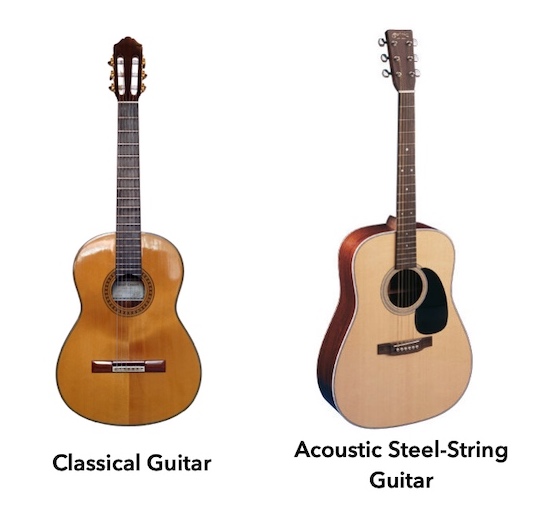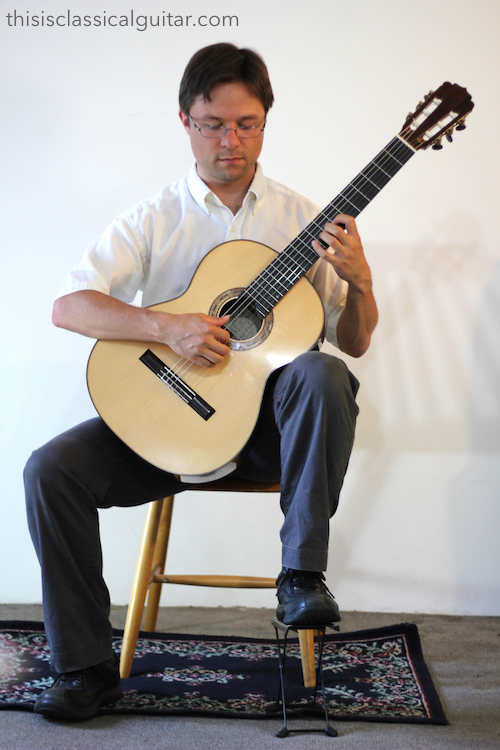
Classical vs Acoustic Guitars – What is the difference between classical guitars and acoustic guitars and what type of guitar should you play as a beginner? Technically, both instruments are acoustic and come in a variety of types and sizes but the names imply some big differences between the instruments. When referring to acoustic guitar we generally are talking about “steel-string acoustic guitar” (more on that below). If you already know you want to play classical guitar you can check out my free pdf method book or my free lesson page.
Super Quick Summary: Classical guitars use nylon strings which are plucked by the fingers and have wider spaced strings. Acoustic steel-string guitars use steel strings with a closer spacing for optimal use of a right hand pick (plectrum) but still possible to play with the fingers. Both instruments usually have 6 strings and can be played in similar ways but each has a specific place stylistically and in terms of suitability or preference for certain music genres. Or course, both instruments have been used across the various genres but some are more common than others. Classical guitars usually have no electronics.
Nylon Strings vs Steel Strings
Classical guitars use nylon strings and acoustic guitars use steel strings. Nylon strings are larger diameter and lower tension than steel strings. The two different types of strings produce a very different sound. They also feel quite different with nylon strings being more gentle on your fingers and easier to push down to the fret (a generalization but true most of the time). There are actually a huge variety of materials for nylon strings these days from clear nylon to composite materials with titles such as carbon, titanium, nylgut and many more. Some are much higher tension than others. The same goes for steel strings that have a variety of tensions.
Never put steel strings on a classical guitar as the higher tension and thin diameter of the string can damage the instrument. Although nylon strings might not damage an acoustic steel-string guitar, you’ll find that the setup and string spacing will not work well with nylon strings.
Tuning pegs – Also keep in mind that the tuners on the headstocks are quite different. You usually can not wind a nylon string on a steel-string tuner as the thick diameter may not fit in the hole or have enough room to wind around the peg.
String Installs – Nylon classical guitar strings are tied onto the headstock and bridge of the guitar. Acoustic steel-string guitars usually have a ball end to pressure fit into a hole in the bridge with a string peg. See my article on How to String a Classical Guitar – A Guide to Changing Strings.
Neck and Fingerboard Differences
The next big difference between classical and acoustic guitars is the neck profile and string spacing on the fingerboard. Because classical guitar is played by the right hand fingers and can be quite congested and specific in the left hand the string spacing is wider than acoustic guitars. Of course, there are a variety of different models of guitar on both sides that lean in one direction or the other but classical guitars tend to be much wider in spacing. The neck profiles are also difference with classical guitars having a wider fingerboard and neck. Many electric and acoustic guitars have a small enough neck profile that the neck can be fully palmed while playing whereas the classical guitar is wide enough that the thumb generally stays behind the fingerboard on the neck.
Body Size and Shape
There is a large variety of shapes and sizes for each type of guitar but the typical chord-strumming acoustic steel-string has a large body and string length. The build quality is also much different since acoustic guitars are built tough to withstand the tension of steel-strings and the type of use it generally gets. Also keep in mind the different ways we sit with the instrument and how the instrument is better suited to each.


More Small Differences
Fret markers – Steel-string guitars tend to have markers at the 3rd, 5th, 7th, 9th, and 12th frets. Classical guitar can have none or just a few.
Bridge – Classical Guitars have a tie block where the strings get tied on in certain way. Steel-strings have string pegs that pressure fit the string in place.
Volume and Tone – Classical guitars generally sound warmer and more mellow than bright steel-strings but there is quite a bit of variation that occurs.
Stylistic and Historical Performance Preference
Classical guitars can mean different things to different musicians. Nylon string guitars could fall into the category of classical guitar, Latin American guitar, flemenco and Spanish guitar, ‘Western’ art music so Renaissance, Baroque, Classical, and Romantic era music. The list is endless. That said, musicians have used classical guitars in all genres from classical music to rock and jazz so there is no strict box that it fits into.
Here’s an example of classical guitar playing.
Here’s an example of steel-string with voice.
Videos on the Topic
Reference Articles
More Articles to Help with Classical Guitar
- Basic Technique Overview Video – Slideshow of Photos, Tips, & Diagrams
- Sitting Position for Classical Guitar – Video, Photos, Tips, Diagrams
- Right Hand Position for Classical Guitar – Video, Photos, Tips, Diagrams
- Left Hand Position for Classical Guitar – Video, Photos, Tips, Diagrams
Image Use:




